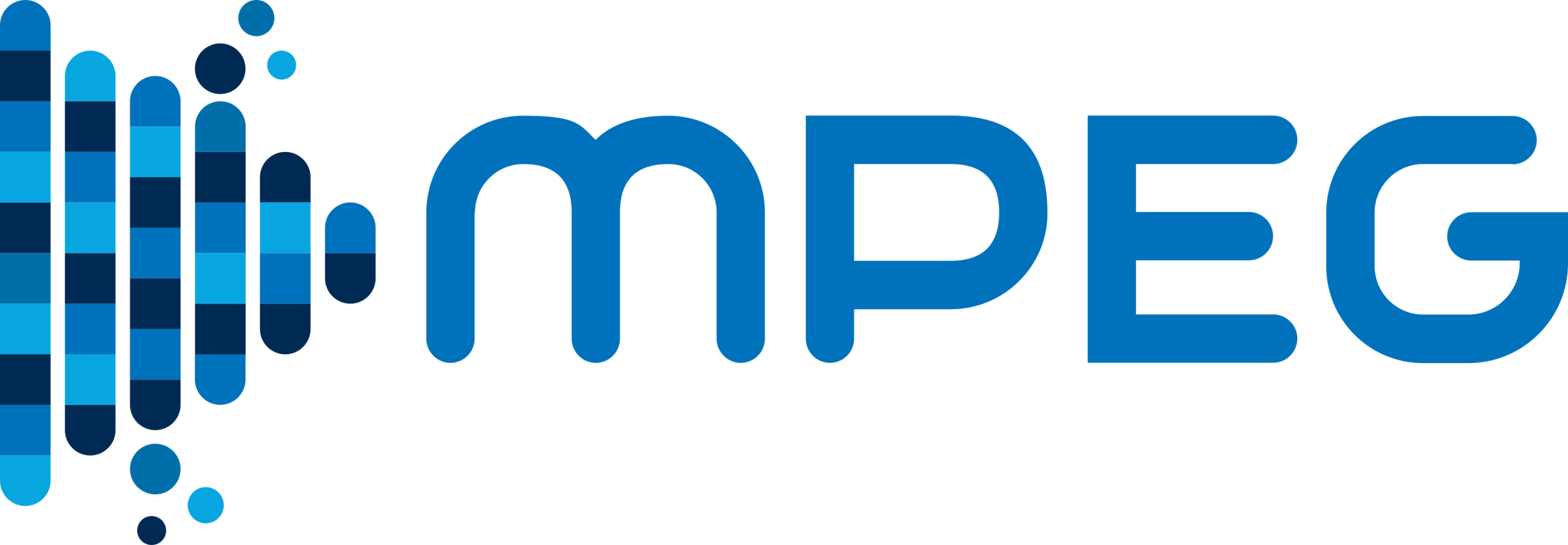The 145th meeting of MPEG took place in Hanover from 2024-01-22 until 2024-01-26. Find more information here.
Latest Edition of the High Efficiency Image Format Standard Unveils Cutting-Edge Features for Enhanced Image Decoding and Annotation
At the 145th MPEG meeting, MPEG Systems (WG 3) ratified the third edition of its High Efficiency Image Format (HEIF; ISO/IEC 23008-12: Image file format). HEIF has solidified its position as one of the most rapidly and widely adopted standards in the imaging industry. The newest edition represents a significant leap forward, introducing progressive decoding capabilities that elevate image quality through a sequential, single-decoder instance process. This enhancement empowers users to decode a bitstream in successive steps, with each phase delivering perceptible improvements in image quality compared to the preceding step.
Additionally, this edition introduces a sophisticated data structure that meticulously describes the spatial configuration of the camera and outlines the distinctive characteristics of the camera responsible for generating the image content.
Furthermore, the updated HEIF specification encompasses innovative tools for annotating specific areas in diverse shapes, enhancing the versatility of image content manipulation. The inclusion of these annotation features adds a layer of creativity and customization, catering to the diverse needs of users across various industries.
Not stopping at these remarkable upgrades, the HEIF standard is actively advancing its technology portfolio. The ongoing development efforts promise to introduce support for renderable text items, providing a comprehensive solution for incorporating textual elements seamlessly into images. Additionally, the inclusion of slim versions of image files addresses the demand for efficient use cases, particularly for smaller image sizes such as icons.
MPEG Systems finalizes Standards supporting Interoperability Testing
At the 145th MPEG meeting, MPEG Systems (WG 3) finalized two standards comprising conformance and reference software by promoting it to the Final Draft International Standard (FDIS), the final stage of standards development. This pivotal milestone represents the culmination of rigorous standards development and underscores MPEG Systems’ commitment to innovation and excellence in the field.
The finalized standards, ISO/IEC 23090-24 and ISO/IEC 23090-25, showcase the pinnacle of conformance and reference software for scene description and visual volumetric video-based coding data, respectively. These standards offer not only reference implementations but also essential bitstreams for conformance testing, ensuring robustness and reliability in real-world applications.
ISO/IEC 23090-24 focuses on conformance and reference software for scene description, providing a comprehensive reference implementation and bitstream tailored for conformance testing related to ISO/IEC 23090-14, scene description. This standard opens new avenues for advancements in scene depiction technologies, setting a new standard for conformance and software reference in this domain.
Similarly, ISO/IEC 23090-25 targets conformance and reference software for the carriage of visual volumetric video-based coding data. With a dedicated reference implementation and bitstream, this standard is poised to elevate the conformance testing standards for ISO/IEC 23090-10, the carriage of visual volumetric video-based coding data. The introduction of this standard is expected to have a transformative impact on the visualization of volumetric video data.
Both standards, ISO/IEC 23090-24 and ISO/IEC 23090-25, will be made freely accessible for download on the official ISO website, ensuring widespread availability for industry professionals, researchers, and enthusiasts alike. This commitment to openness and accessibility aligns with MPEG Systems’ mission to contribute to the broader technological community and foster collaboration.
MPEG finalizes the Third Edition of MPEG-D Dynamic Range Control
At the 145th MPEG meeting, MPEG Audio Coding (WG6) completed the work on the third edition of ISO/IEC 23003-4, Dynamic range control, promoting it to the Final Draft International Standard (FDIS) stage. This update incorporates two amendments into the second edition, originally published in 2020.
The third edition includes the specification of dynamic range control (DRC) side chain information and metadata-based real-time loudness leveling for live workflows. The technologies enable producers of live content, such as sports broadcasts and concerts, to seamlessly integrate MPEG-D DRC-based loudness leveling into their existing workflows. The metadata-based approach offers highest possible quality of loudness processing and dynamic range control while maintaining full flexibility and control in playback devices. The technology can be tightly integrated with existing audio codecs such as MPEG-D USAC, MPEG-H Audio or any other audio codec supporting MPEG-D DRC.
MPEG finalizes the Second Edition of MPEG-4 Audio Conformance
At the 145th MPEG meeting, MPEG Audio Coding (WG6) celebrated the completion of the second edition of ISO/IEC 14496-26, audio conformance, elevating it to the Final Draft International Standard (FDIS) stage. This significant update incorporates seven corrigenda and five amendments into the initial edition, originally published in 2010.
ISO/IEC 14496-26 serves as a pivotal standard, providing a framework for designing tests to ensure the compliance of compressed data and decoders with the requirements outlined in ISO/IEC 14496-3 (MPEG-4 Audio). The second edition reflects an evolution of the original, addressing key updates and enhancements through diligent amendments and corrigenda.
This latest edition, now at the FDIS stage, marks a notable stride in MPEG Audio Coding’s commitment to refining audio conformance standards and ensuring the seamless integration of compressed data within the MPEG-4 Audio framework.
MPEG Genomic Coding extended to support
Transport and File Format for Genomic Annotations
At the 145th MPEG meeting, the MPEG Genomic Coding (WG 8) working group extended the support of transport and file format to the coding of any common type of annotations obtained by the analysis results of DNA sequencing data.
The ISO/IEC 23092-1 (3rd edition) – Transport and file format, supporting a joint coding of sequencing and annotation data, has been promoted to Final Draft International Standard (FDIS). The current MPEG-G standard series (ISO/IEC 23092) can now support full application pipelines, covering data representation and compression from the output of the sequencing up to the results of tertiary analysis support in a single structured transport and file format. The extended structured and compressed representation provides the basis for standard APIs implementing advanced standard browsing and searching features. They include standard APIs for exact and approximate string-matching capabilities directly in the compressed domain for sequencing data metadata and annotations. These new standard functionalities are fundamental for searching large databases of compressed sequencing and annotation data resulting from the massive amounts of sequencing data that are generated by next generation sequencing technologies.
In addition, the MPEG Genomic Coding working group also reached the first milestone for the 2nd edition of ISO/IEC 23092-5 (MPEG-G Part 5, Conformance) by promoting the text to Committee Draft (CD) status. This new edition incorporates support for the newly issued Part 6 of the MPEG Genomics family of standards: the coding of genomic annotations. The conformance standard supports detailed diagnostic assessment of decoder implementations so that conformant implementations can be certified and can provide functional guarantees as required by regulations of diagnostic devices.
MPEG White Paper
At the 145th MPEG meeting, MPEG Liaison and Communication (AG 3) approved the following MPEG white paper, which is available at https://www.mpeg.org/whitepapers/.
Neural Network Coding (NNC) – Efficient Storage and Inference of Neural Networks for Multimedia Applications
Artificial neural networks have been adopted for a broad range of tasks in almost every technical field, such as medical applications, transportation, network optimization, big data analysis, surveillance, speech, audio, image and video classification, image and video compression, and many more. An additional factor for the exponential growth is the appearance of new use cases, such as federated learning with continuous communication between many devices. To effectively reduce bandwidth usage in communication and reduce the size of networks for inference, achieving an optimal compression ratio must be prioritized. Thus, a standard for neural network coding (NNC) has been defined in ISO/IEC 15938-17 (Compression of Neural Networks for Multimedia Description and Analysis), with the second edition adding new compression tools and support for coding incremental updates of neural networks.
Incremental coding, one of the main extensions in the second edition, targets neural network updates as a difference signal between a base neural network (i.e., an instance of a trained neural network for the particular use case) and an updated neural network. The updated neural network is typically the result of one of the following operations (this list is considered non-exhaustive), for example:
- The base neural network is retrained with other data or hyper-parameters.
- The base neural network and the updated neural network are compressed versions of the same network with different compression ratio.
- The updated neural network is the result of applying transfer learning, starting from the base neural network.
- The updated neural network uses the base neural network in its structure (possibly retrained end-to-end).

